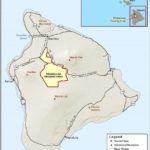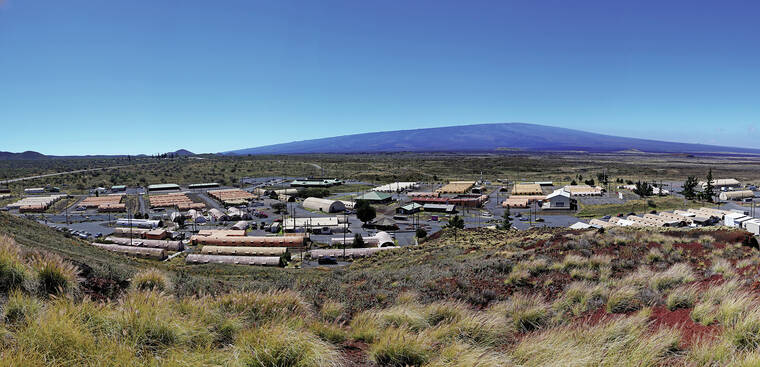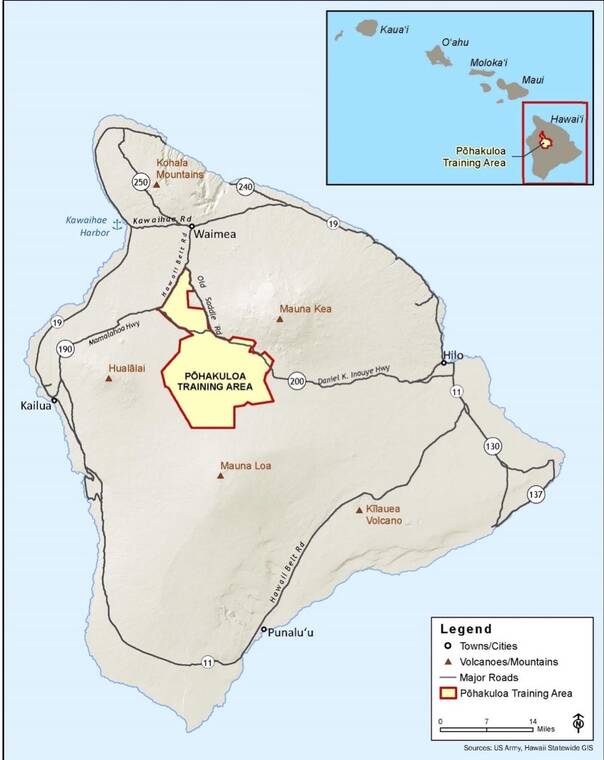The U.S. Army is requesting public feedback on a draft environmental impact statement that will determine whether part of the Pohakuloa Training Area will remain under Army management.
Released Friday, the 397-page review lists the various environmental impacts caused by the Army’s use of the training area in order to determine future actions as the expiration of a lease with the state looms.
PTA itself covers 132,000 acres. However, 23,000 of those are leased from the state, and that lease expires in 2029.
Those 23,000 acres contain the garrison and Bradshaw Army Airfield, and connects those facilities and other parcels of PTA owned by the federal government.
“The Army has a process — Army Training Land Retention — and it’s incredibly important to us that we follow that process,” said Lt. Col. Kevin Cronin, PTA garrison commander. “We welcome all input from the community on the matter.”
The review lists four possible actions by the Army pending further consideration, ranging from full retention of all 23,000 acres of state land, partial retention of the land, or vacating the state land entirely. However, the draft statement does not list a preferred option, which will instead be identified in a final review at a later date.
The partial retention proposals would limit the Army to either 19,700 acres or 10,100 acres, although it would still have access to Army facilities and utilities on the vacated land.
Each one of the options has been evaluated for its impacts on several environmental factors, from biological resources, to water, to traffic, to noise, and more. According to the review, each option will have “less than significant impact” on the vast majority of environmental factors.
There are some exceptions, however. All options wherein the Army retains any of the land will have “significant adverse impact but mitigable to less than significant (impact)” on traditional and customary practices, while vacating the land will have a “significant beneficial impact,” according to the review.
“(Land retention) would result in no new impacts to traditional and customary practices, yet there would be continued long-term, significant, adverse impacts from ongoing limitations on access resulting from Army control of the state-owned land,” the review read, recommending that the Army consult with Native Hawaiians to provide access to promote and protect cultural resources.
Vacating the state land entirely was found to have some negative impacts as well. The review — which was conducted by the Army — found that, without Army access to the land, its conservation measures for the area would cease, resulting in adverse effects on protected species in the area.
Meanwhile, it notes that retaining the land will result in “continued long-term, minor, adverse impacts to biological resources from ongoing activities,” which the review deems “less than significant.”
The review also argues that vacating the land would have an adverse socioeconomic impact, with a loss of about 76,000 jobs and a reduction in $92 million in local spending. Similarly, it argues that vacating the land may require the Army to remove utilities such as communication infrastructure, fire protections systems and more.
The review also notes that none of the options will have any impact whatsoever on historical architecture by the simple expedient of there not being any in the area.
Members of the public can submit comments on the statement until June 7.
Comments can be submitted online — at tinyurl.com/mrf2am9d, where the statement can also be viewed — via email at ATLR-PTA-EIS@g70.design, by mail to ALTR PTA EIS Comments, P.O. Box 3444, Honolulu, HI 96801-3444, or at two public meetings to be held later this month.
The public meetings will take place from 6-8 p.m. April 25 at ‘Imiloa Astronomy Center and from 6-8 p.m. April 26 at Waimea District Park. During those meetings, people can also submit comments by telephone at (808) 470-8884.
Email Michael Brestovansky at mbrestovansky@hawaiitribune-herald.com.






